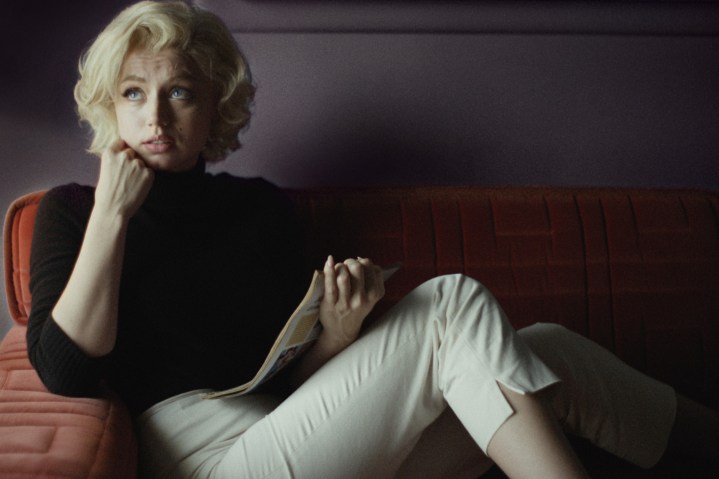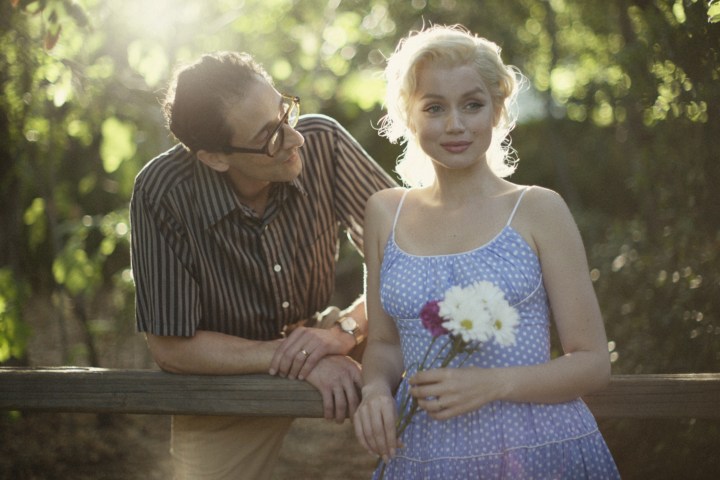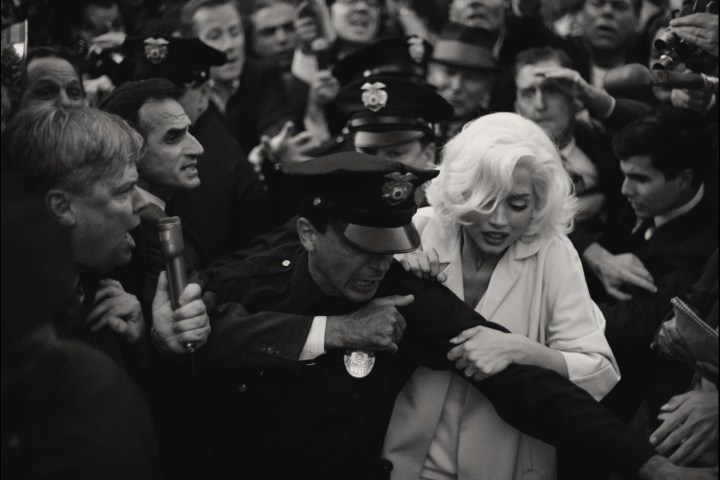Andrew Dominik’s Blonde opens, quite fittingly, with the flashing of bulbs. In several brief, twinkling moments, we see a rush of images: cameras flashing, spotlights whirring to life, men roaring with excitement (or anger — sometimes it’s hard to tell the difference), and at the center of it all is her, Marilyn Monroe (played by Ana de Armas), striking her most iconic pose as a gust of wind blows up her white dress. It’s an opening that makes sense for a film about a fictionalized version of Monroe’s life, one that firmly roots the viewer in the world and space of a movie star. But to focus only on de Armas’ Marilyn is to miss the point of Blonde’s opening moments.
Contents
- Not your usual biopic
- A technical triumph
- A great lead performance
- Less is more
As the rest of Dominik’s bold, imperfect film proves, Blonde is not just about the recreation of iconic moments, nor is it solely about the making of Monroe’s greatest career highlights. It is, instead, about exposure and, in specific, the act of exposing yourself — for art, for fame, for love — and the ways in which the world often reacts to such raw vulnerability. In the case of Blonde, we’re shown how a world of men took advantage of Monroe’s vulnerability by attempting to control her image and downplay her talent.
Blonde does not always succeed at correcting that very sin. There are moments when Dominik, unfortunately, seems to be further playing into the over-sexualization and infantilization of Monroe that has run rampant for decades, and which attempts to render her as nothing more than a naïve sexpot without any agency of her own. But there are also moments in which Blonde feels like it wants nothing more than to honor Monroe not just as a movie star for the ages, but as a brave and capable artist.
Related
- Decision to Leave review: An achingly romantic noir thriller
- Tár review: Cate Blanchett soars in Todd Field’s ambitious new drama
- Entergalactic review: a simple but charming animated romance
Not your usual biopic

Blonde, which is based on Joyce Carol Oates’ divisive 2000 novel of the same name, does not attempt to tell the true story of Marilyn Monroe’s life. Instead, what the film presents is an impressionistic portrait of how Norma Jeane Mortenson, the woman who became the movie star known as Marilyn Monroe, was used and abused by the very people who were supposed to protect and support her. The film’s culprits are many and wide-ranging — covering everyone from Marilyn’s abusive and emotionally unstable mother (Julianne Nicholson) to the retired baseball star who became her second husband (played by Bobby Cannavale) and, eventually, the leader of the free world himself (Caspar Phillipson).
Nearly everyone in the film is based upon people from Monroe’s real life, but its depictions of them are, at times, greatly separate from reality. It’s important to note that up front because, for some viewers, the film’s decision to envision Monroe’s life as being potentially more traumatic than it really was may simply be seen as too big of an ask. For others, like myself, the film’s lies may only help the truths about Monroe’s life and legacy — both the painful and euphoric ones — cut that much deeper. The film, to its credit, doesn’t try to present itself as a grounded biopic, either.
Clocking in at a whopping 166 minutes, Blonde floats through its story, adopting a leisurely pace and editorial style that actively bucks against any kind of traditional narrative structure. Watching it doesn’t feel like you’re being led through a typical three-act story but rather a neverending montage that only occasionally stops along the way to painstakingly recreate iconic images from Monroe’s career. There are certain scenes, in fact, where it’s hard to tell whether you’re watching de Armas’ version of Monroe or stock footage of the real woman, which only further heightens the disorienting effect that Blonde frequently achieves.
A technical triumph

Dominik, who has always been prone to visual experimentation, also uses practically every aspect ratio known to man throughout Blonde. The film, therefore, not only repeatedly switches back and forth from pristine black and white photography to technicolor, but it does so while also flipping between vast widescreen 16:9 images and smaller 4:3 compositions. At times, these instances of visual invention feel random, as if they exist solely to further disorient and detach you from reality. In other moments, they feel purposeful and calculated.
Look, for instance, at how the film’s aspect ratio changes on the night Marilyn expects to meet her long-lost father. The film briefly becomes a widescreen picture as Marilyn walks into her hotel room, reflecting the emotional importance she has placed on the moment. Notice then how the aspect ratio begins to shrink, the scope of the scene slowly, visually dwindling, once she realizes it’s not her father waiting for her but Cannavale’s former ballplayer. Notice further how — in a moment of subtle but precise physical acting — Cannavale’s hand slowly surrounds de Armas’ neck as he professes his love for her, his own body unknowingly foreshadowing their relationship’s toxic and abusive future.
Working with cinematographer Chayse Irvin and editor Adam Robinson, Dominik also fills Blonde with some of the most ingeniously constructed dreamlike images you’ll see in a movie this year. One scene, in specific, comes early on in Blonde and finds de Armas’ Norma Jeane gripping the edge of a bed in a moment of sexual ecstasy. As she does, the bedsheets, which spill down the side of the bed, slowly and impossibly transform into Niagara Falls. Dominik then uses this moment to transition from a mid-afternoon tryst to a promotional trailer for the 1953 noir gem, Niagara. Playing over all of these scenes, meanwhile, is Nick Cave and Warren Ellis’ ethereal, otherworldly score, which not only ranks as one of the year’s best but also lifts Blonde‘s overwhelming tragic mood to cosmic heights.
A great lead performance

At the center of Blonde’s many surreal images and nightmarish sequences, though, is Ana de Armas, whose performance as Marilyn Monroe feels perfectly calibrated for the film she’s in. The actress looks strikingly similar to Monroe throughout all of Blonde, but much like the film itself, there is an ever-present, often haunting discontent between de Armas and the woman she’s playing.
Part of that has to do with de Armas’ real-life Cuban accent, which never fades even in the moments when the actress herself is leaning all the way into Monroe’s breathy way of speaking. There is also a raw quality to de Armas’ performance, which not only rises to the top of Blonde’s many emotionally difficult scenes but also imbues the moments when she is recreating Monroe’s work in films like Some Like It Hot and Gentlemen Prefer Blondes with added touches of tragedy and rage.
Her performance allows de Armas to predictably outshine nearly everyone else that appears opposite her in Blonde. Adrien Brody does, however, make a heartfelt, quiet mark with his lovestruck performance as Arthur Miller, the celebrated playwright who became Monroe’s third husband. Together, Brody and de Armas create a palpable, romantic warmth that permeates throughout Blonde’s most emotionally bright, if not entirely happy, section.

As Marilyn, de Armas leaves next to nothing on the table, but the film asks too much of her and frequently fails to rise to her level. That’s evidenced by the fact that there are simply too many scenes in Blonde — especially in its second half — that require de Armas to be either topless or fully naked, a detail that threatens to further endorse the over-sexualization that has long plagued Monroe’s legacy. In order to communicate her inner longing and loneliness, Dominik also has de Armas’ Monroe constantly refer to every man in her life as “daddy,” which is a decision that could have been tolerable had it been used a bit more sparingly.
Less is more
De Armas’ frequent use of “daddy” is ultimately a symptom of Dominik’s own inability to sense the moments when less would, indeed, be more. The same can be said for the multiple instances where Dominik’s camera goes inside Monroe’s belly to show CGI versions of her unborn children as they speak to her (yes, literally). The film also features a handful of terribly on-the-nose music cues, including the time when “Bye Bye Baby” begins to play just seconds after de Armas’ Monroe has been coerced into having an abortion that she didn’t want.
These missteps are just a few of the imperfections that prevent Blonde from being as tonally and narratively successful as, say, Dominik’s 2007 directorial effort, The Assassination of Jesse James by the Coward Robert Ford. However, they’re not egregious enough to render Blonde a wholly unsuccessful endeavor. As a matter of fact, Dominik still tells a moving story of loneliness, regret, and emotional yearning with Blonde, a film that feels less like an outlandish Hollywood dream and more like a nightmarish descent into a dark void.
BLONDE | Official Trailer | Netflix
The film achieves that effect whenever it shifts its focus away from Monroe’s sex symbol status and more toward her merits as a performer and artist. In Blonde, Monroe is both a young woman searching for the father figure she never knew and an intelligent, talented artist who wants nothing more than to be given as much as she gives. It should go without saying which of those aspects of Blonde’s Marilyn prove to be more compelling, but the film’s occasionally uneven handling of her legacy doesn’t stop its ideas about celebrity — both the costs and requirements of it — from ringing loud and clear.
In the end, it isn’t Blonde’s various homages to Marilyn Monroe’s real-life career that prove to be its most fruitful moments, either. Instead, it’s the quietest scenes that end up leaving the biggest marks, like one that comes late in the film and follows de Armas as she desperately searches her house for a tip only to find her delivery boy long gone by the time she’s returned to give it to him. Pay attention in this scene to the way that de Armas’ hand lingers in the air, the five dollars still clutched in her palm, even after she realizes that there’s no one on the other side of her gate. It’s a specific kind of heartbreak, realizing only too late that you have yet to find someone willing to put in as much effort for you as you would for them.
Blonde is playing in select theaters now. It premieres Wednesday, September 28 on Netflix.
Editors' Recommendations
- Rosaline review: Kaitlyn Dever lifts up Hulu’s Romeo and Juliet rom-com riff
- Amsterdam review: An exhausting, overlong conspiracy thriller
- Vesper review: an imaginative sci-fi adventure
- God’s Creatures review: an overly restrained Irish drama
- Meet Cute review: Peaco*ck’s time travel rom-com falls flat